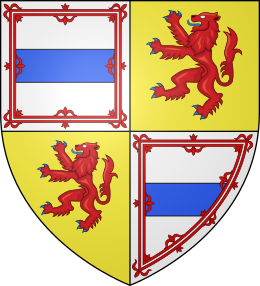Clan Charteris facts for kids
Quick facts for kids Clan Charteris |
|||
|---|---|---|---|

Crest: A dexter hand holding up a dagger paleways Proper.
|
|||
| Motto | This is our Charter | ||
| Profile | |||
| Region | Scottish Lowlands | ||
| Chief | |||
 |
|||
| The Right Honourable James Charteris | |||
| Earl of Wemyss and March | |||
| Seat | Gosford House, East Lothian | ||
|
|||
|
|||
Clan Charteris is a Scottish clan from the Scottish Lowlands. Clans are like big families or groups of people who share a common ancestor and a strong bond.
Contents
History of Clan Charteris
Where Did the Name Charteris Come From?
The name Charteris might come from the city of Chartres in France.
How the Clan Began
The story goes that William, a son of the Lord of Chartres, came to England during the Norman conquest of England. Later, his son or grandson traveled to Scotland with David I of Scotland. One of the first times the name Charteris appears is in a document from around 1174. It was written in Latin as de Carnoto.
A document from 1266 shows four generations of the Charteris family. In 1280, Sir Thomas de Charteris became the Lord Chancellor of Scotland. This was a very important job, like a chief advisor to the king, Alexander III of Scotland.
Fighting for Scottish Independence
In 1296, Andrew de Charteris first agreed to be loyal to Edward I of England. His name is on a list called the Ragman Rolls. However, he soon joined the fight for Scotland's freedom. Because of this, his lands were taken away by John Balliol, who was the English-supported King of Scotland.
Andrew's son, William Charteris, was a strong supporter of Robert the Bruce. He was with Bruce when Comyn was killed in Dumfries in 1306. Sir Thomas Charteris also stayed loyal to the Scottish King. He was sent as an ambassador to England. In 1342, David II of Scotland made him Lord High Chancellor of Scotland. Sir Thomas lost his life at the Battle of Durham in 1346.
Clan Conflicts in the 1500s
In 1526, the Charteris clan had a disagreement with the Clan Kirkpatrick. Records show that John Charteris of Amisfield and his family were involved in a serious incident with Roger Kilpatrick.
In 1530, a famous duel took place. Sir Robert Charteris, the eighth chief, fought Sir James Douglas of Drumlanrig. This was one of the last great knightly contests. The king himself watched the fight. It was so intense that Charteris's sword broke. The king had to send his men to stop the duel.
Another part of the clan was the Charterises of Kinfauns. They argued with their cousins from Dumfriesshire over who was the true chief. The Kinfauns branch supposedly received their lands for helping Robert the Bruce. However, they often had conflicts with the Clan Ruthven. The Ruthvens were very powerful in Perth from their Huntingtower Castle.
In 1544, Patrick, Lord Ruthven, was chosen as the leader of Perth. But a powerful church leader, Cardinal Beaton, had Ruthven removed. Charteris of Kinfauns was then appointed instead. The people of Perth did not accept Charteris. They closed the city gates against him. Charteris, along with Lord Gray and the Clan Leslie, then attacked the town. But the Ruthvens, helped by the Moncreiffs, pushed them back. Ruthven remained the leader of Perth until 1584. John Charteris had been killed by the Earl of Gowrie's heir in Edinburgh in 1552.
The 1600s and Civil War
Sir John Charteris of Amsfield was chosen to help confirm an important agreement in 1641. John supported the National Covenant, a Scottish religious movement. However, he did not fight against the king. Because of this, he was held in Edinburgh in 1643. He was released in March 1645.
Afterward, he joined the forces of James Graham, 1st Marquis of Montrose. He was with the royal army when they were surprised at the Battle of Philiphaugh in September 1645. John's brother, Captain Alexander Charteris, was also with Montrose. He was with him during a difficult campaign in Caithness in 1650. Alexander Charteris was captured with Montrose. He was put to death in Edinburgh on June 21, 1650. The family's lands then passed to Thomas Hogg, who later took the name Charteris.
The 1700s and 1800s
Colonel Francis Charteris was a male descendant of the family. He bought lands near Haddington. He renamed these lands Amsfield to remember his ancestor's home. He had only one daughter, Janet. She married the Earl of Wemyss. Their second son was Francis Wemyss, who later took the name Charteris.
The Charteris lands near Haddington have since been sold. However, Gosford House is still the home of the Earl of Wemyss and March. This Earl is the current chief of the Charteris name and family.
The Clan Chief
Since 2008, the chief of Clan Charteris has been The Right Honourable James Donald Charteris. He holds several important titles, including Earl of Wemyss and March.
See also

